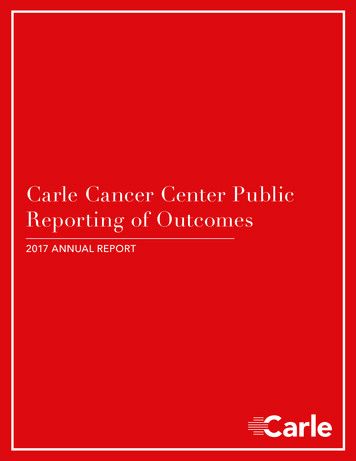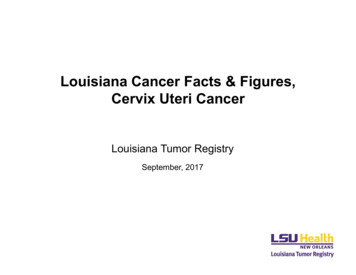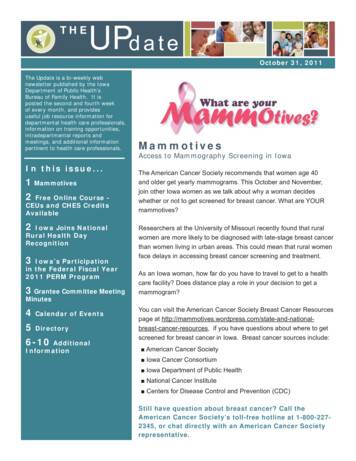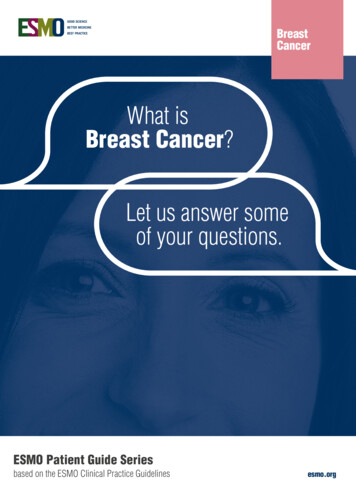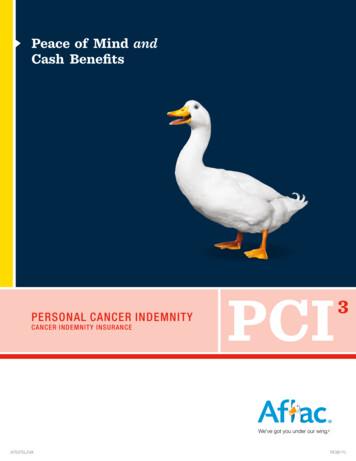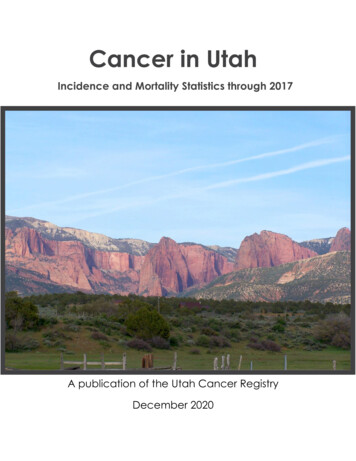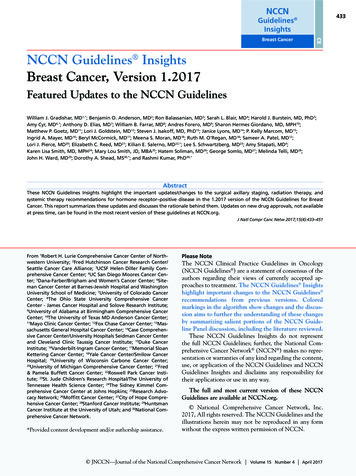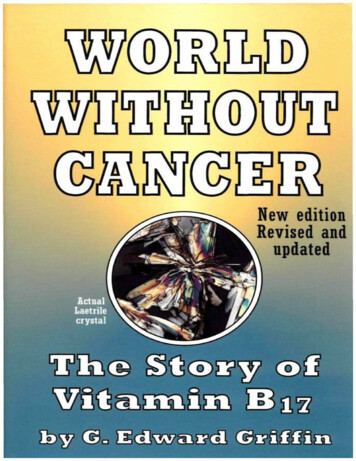
Transcription
e Story of Vitamin B17Second EditionG. Edward Griffin——————————
Sixteenth printing: April 2001 Fifteenth printing: March 2000 Fourteenthprinting: April 1999 Thirteenth printing: April 1998 Twelfth printing:January 1997 Eleventh printing: August 1980 Tenth printing: July 1978Ninth printing: July 1977 Eighth printing: December 1976 Seventhprinting (hardbound): June 1976 Sixth printing: June 1976 Fifth printing:May 1976 Fourth printing: January 1976 Third printing: June 1975Second printing: March 1975 First printing: December 1974Japanese edition 1978Second edition: January 1997 First edition: December 1974Copyright 1997 and 1974 by G. Edward Griffin All rights reservedPublished by American Media Post Office Box 4646 Westlake Village,California 91359–1646Library of Congress Catalog Card Number: 96–84094International Standard Book Number (ISBN): 0–912986–19–0Printed in The United States of AmericaThis Kindle version prepared by PapaLazzzaru, Aug 2013.——————————With billions of dollars spent each year on research, with other billionstaken in on the sale of cancer-related drugs, and with fund-raising at anall-time high, there are now more people making a living from cancerthan dying from it. If the solution should be found in a simple vitamin,this gigantic industry could be wiped out overnight. The result is that thepolitics of cancer therapy is more complicated than the science.WORLD WITHOUT CANCER blazes the trail into unexplored territoryand reveals how science has been subverted to protect entrenchedcommercial interests. It delivers the kind of impact that could topple anempire; and perhaps it will.
G. EDWARD GRIFFIN is a writer and documentary film producer withmany titles to his credit. Listed in Who’s Who in America, he is wellknown for his unique talent for researching difficult topics and presentingthem in terms that all can understand. He has dealt with such diversifiedsubjects as the Federal Reserve System, archaeology and ancient earthhistory, international banking, internal subversion, terrorism, the historyof taxation, U.S. foreign policy, the Supreme Court, the United Nations,and the science and politics of cancer. Some of his better known worksinclude The Creature from Jekyll Island, Moles in High Places, TheDiscovery of Noah’s Ark, The Open Gates of Troy, No Place to Hide, TheCapitalist Conspiracy, More Deadly than War, The Grand Design, TheGreat Prison Break, and The Fearful Master.Mr. Griffin is a graduate of the University of Michigan where he majored
in speech and communications. He is the recipient of the coveted TellyAward for excellence in television production, a Contributing Editor forThe New American magazine, the creator of The Reality Zone AudioArchives, and president of American Media, a publishing and multimediaproduction company in Southern California.——————————From paperback dust jacket:G. Edward Griffin marshals the evidence that cancer is a deficiencydisease—like scurvy or pellagra—aggravated by the lack of an essentialfood compound in modern man’s diet. That substance is vitamin B17. Inits purified form developed for cancer therapy, it is known as Laetrile.This story is not approved by orthodox medicine. The FDA, the AMA,and The American Cancer Society have labeled it fraud and quackery. Yetthe evidence is clear that here, at last, is the final answer to the cancerriddle.Why has orthodox medicine waged war against this non-drug approach?The author contends that the answer is to be found, not in science, but inpolitics—and is based upon the hidden economic and power agenda ofthose who dominate the medical establishment.——————————“A clear and revolutionary insight into both the science and politics ofcancer therapy.”Dean Burk, Ph.D., Former Head of Cytochemistry, National CancerInstitute“Mr. Griffin has lifted the veil of mystery from Laetrile.”Dr. Ernst T. Krebs, Jr., Discoverer of Vitamin B17“A milestone of careful research and penetrating analysis.”John A. Richardson, M.D., Albany, California“The most comprehensive picture of the status of health in this world that
I have ever read.”Frederick D. Burton, M.D., Allentown, Pennsylvania“For the first time since I became a nurse 23 years ago, I do not fearcancer!”Mrs. R.K. Bruce, R.X., San Diego, e purpose of this book is to marshal the evidence that cancer is anutritional-deficiency disease. It is not caused by a bacterium, virus ormysterious toxin but by the absence of a substance that modern man hasremoved from his diet. If that analysis is correct, then the cure andprevention of cancer is simple. All that needs to be done is to restore thateasily obtained and inexpensive food factor to our daily meals.This is an exciting theory. It holds the promise for a world without cancernow, not at some distant point in the future, and it would mean that thebillions of dollars spent each year on research and medical treatmentcould be redirected to more happy pursuits. Of course, it also would meanthat the million-or-so professionals now gainfully employed in thecancer-research, cancer-therapy, and fund-raising industries wouldrapidly be out of work. This is where the plot becomes interesting,because these are the same people to whom we have turned for expertopinion regarding the validity of Laetrile, nutritional therapy.It should not be surprising that these experts have rejected the vitamindeficiency concept of cancer. There is nothing in it for them. Not onlywould a world without cancer lead to pay-check shock, it also wouldrepresent a blow to professional prestige. Imagine: a cure for cancerfound in the seeds of fruits, not in research laboratories, and discoveredby people without government grants or prestigious diplomas hanging ontheir walls!Organized medicine has spoken. Laetrile is quackery, it says, and is
derided as an “unproven” cancer treatment. However, let us take a closerlook at that word. For most people, unproven means simply that there isno proof. But what is proof? It is not an absolute concept. In the strictsense, there is no such thing as proof; there is only evidence. If evidenceis convincing to the observer, then it is said to be proof, and the thesiswhich it supports is viewed as “proven.” If a second observer finds thesame evidence to be unconvincing, then it is not proof, and the thesis is“unproven” to that observer.As we shall see in the pages that follow, there is a great deal of evidencesupporting the nutritional-deficiency concept of cancer—more thanenough to convince most people that the thesis is proven. But the wordproven, when used by the FDA, has an entirely different meaning. It is atechnical definition. When the FDA says a therapy is proven, it meansonly that its promoters have complied with the testing protocols set bythe agency to demonstrate safety and effectiveness. It is important toknow, however, that the successful completion of those tests does notmean, as the terminology implies, that the therapy is safe and effective. Itmerely means that tests have been conducted, the results have beenevaluated, and the FDA has given its approval for marketing, often inspite of the dismal results.If cancer patients undergoing these FDA-proven therapies were to readthe actual laboratory reports, they would recoil in horror. They showneither safety nor effectiveness and, in fact, they are not intended to doso. Their purpose is to establish the lethal dose—the point at which thetherapy will kill 50% of the patients—and also to establish the ratiobetween those who are benefited and those who are not. That ratio oftenis in the range of only eight or nine people out of a hundred. Furthermore,“benefited” can mean any slight improvement such as a temporaryreduction in tumor size. It almost never means a complete cure. Ifanything is “proven” by these studies, it is that most FDA-approvedcancer therapies are both unsafe and ineffective.Then there is the question of money. The testing protocols established bythe FDA are costly. The promoters of a new therapy must assign a large
staff of technicians and compile many thousands of statistical pages. Thecomplete reports often weigh hundreds of pounds and stack over six feetin height. The process can take years and consume over two-hundredmillion dollars per study.Only the large pharmaceutical companies can play that game. (Althoughthey publicly complain about this expense, they privately approve,because it prevents competition from smaller companies.) The potentialreward of getting a new product into the world market is well worth theinvestment. But who would be willing to spend that kind of money ondeveloping a product that cannot be patented? Substances found in naturecannot be patented; only those which are invented by man. If a companywere to spend two-hundred-million dollars to obtain FDA approval for anatural substance, its competitors then would be able to market theproduct, and the developer could never recover the investment.Therefore—and mark this well—as long as the present laws remain, theonly substances that ever will be “approved” for cancer therapy will beproprietary. No substance from nature will ever be legally available forcancer or any other disease unless its source can be monopolized or itsprocessing can be patented. No matter how safe and effective it may be,and no matter how many people are benefited, it will forever be relegatedto the category of “unproven” therapies. As such, freely available curesfrom nature will always be illegal to prescribe, to promote, and in manycases even to use.It is partly for these reasons that the following warning and disclaimer isoffered. But even without that background, it is only common sense thatcancer victims should be encouraged to exercise great caution whenselecting their therapy. Be advised, therefore, that Laetrile is, officially,an unproven cancer treatment. The author of this book is a researcherand writer, not a physician. The facts presented in the following pagesare offered as information only, not medical advice. Their purpose is tocreate the basis for informed consent. Although there is much that each ofus can do in the area of prevention, self-treatment for clinical cancer is
not advised. The administration of any cancer therapy, includingnutritional therapy, should be under the supervision of health-careprofessionals who are specialists in their s book is dedicated to the memory of Dr. Ernst T. Krebs, Jr., and JohnA. Richardson, M.D. When confronted by the power and malice ofentrenched scientific error, they did not flinch. While others scamperedfor protective shelter, they moved to the front line of battle. May thetelling of their deeds help to arouse an indignant public which, alone, canbreak the continuing hold of their enemies over our lives and our health.——————————A Note Of Appreciation And GratitudeThe material in this volume could not have been assembled without thehelp and guidance of many others. I am indebted to the late Dr. JohnRichardson for his persistent hammering away on the significance ofvitamin therapy until it finally began to penetrate into this thick skull;and to my wife, Patricia, who, for several months prior, had attempted toarouse my curiosity on the subject. I will always be indebted to the lateDr. Ernst T. Krebs, Jr., for his patience and thoroughness in explainingand re-explaining so many scientific matters. I am grateful to BruceBuchbinder, Ralph Bowman, Malvina Cassese, Frank Cortese, GeorgeHam, Grace Hamilton, Jim Foley, Mac and Idell Hays, Pokie Korsgaard,Sanford Kraemer, Dr. J. Milton Hoffman, Maurice LeCover, Bob Lee,Betty Lee Morales, Beverly Newkirk, John Pursely, Julie Richardson,Bob Riddel, Lorraine Rosenthal, Alice Tucker, Lloyd Wallace, M.PWehling, Kimo Welch, Melinda Wiman, Ann Yalian, and others toonumerous to mention for their strong encouragement, endless patience,and tangible support.——————————
ContentsWARNINGDEDICATIONA NOTE OF APPRECIATION AND GRATITUDEFOREWORD!PART ONE. THE SCIENCE OF CANCER THERAPYCHAPTER ONE THE WATERGATE SYNDROMEExamples of dishonesty and corruption in the field of drug research;a close look at the first major study which declared Laetrile (vitaminB17) “of no value;” proof that the study was fraudulent; the FDA’sruling against the use of Laetrile because it had not been tested; andthe refusal then to allow anyone (except its opponents) to test it.:CHAPTER TWO GENOCIDE IN MANHATTANContinued attempts by the cancer industry to prove that Laetrile isworthless; the suppressed lab reports from the Sloan-KetteringInstitute which proved that Laetrile does work; the Rockefellerconnection to the pharmaceutical industry; the story of how a groupof employees at Sloan-Kettering leaked the truth to the outsideworld.:CHAPTER THREE AN APPLE A DAYA review of entrenched scientific error in history; the vitamindeficiency concept of cancer as advanced in 1952 by Dr. Ernst T.Krebs, Jr.; and a survey of the evidence both in nature and in historyto support that concept.:CHAPTER FOUR THE ULTIMATE TESTA look at the many cultures around the world that are, or have been,free from cancer; and an analysis of their native foods.:CHAPTER FIVE CANCER THE ONRUSH OF LIFEAn explanation of the trophoblast thesis of cancer; a description of asimple urine test for cancer; an appraisal of BCG vaccine as an anti::
cancer agent; and a review of the vital role played by the pancreas inthe control of cancer.CHAPTER SIX THE TOTAL MECHANISMThe nutritional factor as a back-up mechanism to the enzyme factor;a biographical sketch of Dr. Ernst T. Krebs, Jr., and his developmentof Laetrile; the beneficial secondary effects of vitamin B17 on awide range of human disorders; and an appraisal of the complexityof nature’s total natural anti-cancer mechanism.:CHAPTER SEVEN THE CYANIDE SCAREA newspaper account of a couple who reportedly were poisoned byeating apricot kernels; a close look at the facts in this case; anevaluation of the toxic potential of seeds containing B17; and theclinical evidence that Laetrile is less toxic than sugar.:CHAPTER EIGHT THE LAETRILE QUACKSThe names, professional standings, medical achievements, andclinical findings of some of the more prominent doctors whoendorse Laetrile; the beneficial side-effects produced by its use; asuggested anti-cancer diet; and a brief description of vitamin B15.:“”CHAPTER NINE UNPROVEN CANCER CURESClinical evidence in support of the trophoblast thesis; laboratoryexperiments showing that Laetrile kills cancer cells; and casehistories of terminal cancer patients who attribute their recovery tothe effect of Laetrile.DAVID EDMUNDSJOANNE WILKINSONJOE BOTELHOALICIA BUTTONSCAROL VENCIUSMARGARET DeGRIODALE DANNERWILLIAM SYKESBUD ROBINSON:“”
CHAPTER TEN PROVEN CANCER CURESThe effects of surgery and radiation in the treatment of cancerpatients; a comparison showing that those who receive no treatmentat all live just as long, if not longer, than those who are treated.:”CHAPTER ELEVEN A NEW DIMENSION OF MURDERAnti-cancer drugs shown to be ineffective and cancer-causing; FDAapproved experiments on humans resulting in death from drugsrather than from cancer.:CHAPTER TWELVE A STATISTICAL COMPARISONThe inherent weaknesses of all cancer statistics; the need forstatistical comparisons in spite of those weaknesses; a comparisonof the results obtained by orthodox and Laetrile physicians; and theconsequences of consensus medicine.:PART TWO. THE POLITICS OF CANCER THERAPYCHAPTERTHIRTEENCARTELS ESCAPEFROMCOMPETITIONA review of the science of cancer therapy; a summary of the politicsof cancer therapy; the early history of the I.G. Farben chemical andpharmaceutical cartel; the cartel’s early success in the United States;and its “marriage” with DuPont, Standard Oil, and Ford.:—CHAPTER FOURTEEN THE ULTIMATE MONOPOLYEarly examples of cartel support for totalitarian regimes; I.G.Farben’s role in lifting Hitler out of political oblivion andconverting the Nazi state into an instrument of cartel power.:CHAPTER FIFTEEN WAR GAMESGermany’s industrial preparations for World War II; the continuedsupport by American industrialists given to Farben and to the Naziregime during this period; and the profitable role played by Ford andITT in war production for both Nazi Germany and the United States.:CHAPTER SIXTEEN CONSPIRACYEfforts to camouflage Farben ownership of firms in America; the:
assistance rendered by Rockefeller interests; penetration into theU.S. government by agents of the cartel; and the final disposition ofthe Farben case.CHAPTER SEVENTEEN THE ROCKEFELLER GROUPA biographical sketch of John D. Rockefeller, and his crusadeagainst free-enterprise; the beginning of Standard Oil; the entry ofthe Rockefellers into investment banking; their influence in thepharmaceutical industry and international politics.:CHAPTER EIGHTEEN THE CHARITY PRESCRIPTIONThe drug cartel’s influence over the nation’s medical schools; thedrug-oriented training given to all medical students; and the use ofphilanthropic foundations to obtain control over educationalinstitutions.:CHAPTER NINETEEN HE WHO PAYS THE PIPERThe low state of medical education in the U.S. prior to 1910; the roleof the Flexner Report in dramatizing the need for reform; the roleplayed by the Rockefeller and Carnegie foundations in implementingthe Flexner Report; and the use of foundation funding as a means ofgaining control over American medical schools.:CHAPTER TWENTY HE WHO CALLS THE TUNEAMA influence over the practice of medicine in America; how theleadership of the AMA keeps control away from its members; AMAfunding by the drug industry; and examples of interlock between thetwo.:CHAPTER TWENTY ONE THE PROTECTION RACKETCartel agents in the FDA and other agencies of government; the CFRas a control structure over U.S. foreign policy; scientific ineptitudeat the FDA; and the growth of FDA power.-:CHAPTER TWENTY TWO THE ARSENAL OF COMPLIANCEGovernment harassment of the nutrition and vitamin industry; therole played by the media in discrediting Laetrile in the public mind;-:
and a comparison of the cost of Laetrile therapy with that oforthodox cancer treatments.CHAPTER TWENTY THREE THE DOUBLE STANDARDAn analysis of the FDA’s double standard in which harmless nondrug materials such as vitamins and food supplements are burdenedwith restrictions in excess of those applied to toxic and dangerousdrugs.-:CHAPTER TWENTY FOUR TO WALK THE HIGHEST WIREHow doctors are intimidated into not using Laetrile; why thepharmaceutical industry seeks a patentable substitute for Laetrile;and the courageous stand against the FDA and AMA by Laetriledoctors.-:CHAPTER TWENTY FIVE A QUESTION OF MOTIVESWhat has motivated opposition to Laetrile therapy; the limited” vs.“total” conspiracy theories; and the grass-roots backlash as a forcefor change.-:CHAPTER TWENTY SIX A WORLD WITHOUT CANCERAreas of need for further research with vitamin B17; how theLaetrile controversy differs from medical controversies of the past;an analogy of biological and political cancer; and a scenario inwhich both will be conquered ��———ForewordA great deal of drama has been enacted on the cancer stage since the firstedition of this book was published. While it is true that many of theoriginal actors have been replaced by their understudies, the plot of theplay has not changed. This is the outline of that drama.Each year, thousands of Americans travel to Mexico and Germany to
receive Laetrile therapy. They do this because it has been suppressed inthe United States. Most of these patients have been told that their canceris terminal and they have but a few months to live. Yet, an incrediblepercentage of them have recovered and are living normal lives. However,the FDA, the AMA, the American Cancer Society, and the cancerresearch centers continue to pronounce that Laetrile is quackery. Therecovered patients, they say, either had “spontaneous remissions” ornever had cancer in the first place.If any of these people ultimately die after seeking Laetrile, spokesmenfor orthodox medicine are quick to proclaim: “You see? Laetrile doesn’twork!” Meanwhile, hundreds of thousands of patients die each year afterundergoing surgery, radiation, or chemotherapy, but those treatmentscontinue to be touted as “safe and effective.”The average cancer patient undergoing Laetrile therapy will spendbetween 5,000 and 25,000 for treatment. That is a lot of money, but itis peanuts compared to the astronomical bills charged by conventionalmedicine. Yet they never tire of complaining that Laetrile doctors aregreedy quacks and charlatans who profiteer from the sick and thefrightened.That is a classic case of accusing your opponent of exactly what youyourself are doing. It is common today for an elderly couple to give theirentire life savings to a medical center and a battery of attendingphysicians and technicians, all in the vain hope of saving the husband orwife from cancer. Even their house may have to be sold to pay the bills.And the maddening part is that, in most cases, the doctors know there isno chance of long-term success. But the surviving spouse is seldom toldthat.The next time you hear a spokesman for orthodox medicine condemnthose greedy, money-grubbing Laetrile doctors, watch him as he goes tothe parking lot. Chances are, he’ll drive off in his new Jaguar.The only real difference between the controversy today and when it beganin the 1970s is that the media has lost interest in it. The sparsity of
coverage has created the false impression that Laetrile has fallen intodisfavor, but nothing could be further from the truth. The number ofpatients using Laetrile today continues to run in the thousands.It has been suggested that the mass media have decided to ignore Laetrilebecause, when it did receive national publicity, it became popular. Peopledecided to give it a try in spite of the negative press. If they had been toldthey were going to die anyway, why not? And the clinics in Mexicothrived. Another reason may be that, although the controversy continues,there is nothing of substance that is really new. Each unfolding event ismerely an extension of forces and arguments that have preceded.For example, in 1977, the parents of Chad Green kidnaped their own sonand took him to Mexico to avoid being forced by officials inMassachusetts into giving him chemotherapy for his leukemia. Theypreferred nutritional therapy instead. This is part of the heavy price wepay for allowing government the power to decide what is best for us andour families. When special-interest groups become politically strongenough to write the laws, then it is those groups that tell us what to do-allin the name of protecting us, of course.The Chad Green story made big headlines but, unfortunately, the samething involving other children has happened numerous times since thenwith only minor news coverage. For example, in 1999, James and DonnaNavarro were told that their four-year-old son, Thomas, had a malignantbrain tumor. Surgery left the child speechless, blind, and unable to walk.When the doctors told the Navarros that Thomas would also have toundergo radiation and chemotherapy, they researched the medicalliterature and learned that these treatments probably would further impairthe boys brain function and that long-term survival was unlikely anyway.So they decided to try an alternative therapy called antineoplastonsoffered at the Stanislaw R. Burzynsky Research Institute in Houston. Atthis point, the FDA stepped in and prohibited Dr.Burzynsky from accepting the boy as a patient unless he first hadundergone chemotherapy and radiation.
Mr. Navarro explains: “What they don’t understand is that there won’t beanything left of him to salvage if we make him take that awful treatmentfirst.” When he did not fall in line with the doctors’ demands, he began toreceive harassing phone calls from hospital personnel. One oncologistthreatened to file charges with the state. When Mr. Navarro still refused,the doctor went to the protective-services agency and filed child-abusecharges against the parents.In 1980, movie actor Steve McQueen also made news when he went toMexico for Laetrile and other unorthodox therapies. When he diedfollowing surgery four months later, the press had a heyday telling theAmerican people that Laetrile didn’t work. What they failed to report isthat McQueen’s cancer was, indeed, apparently cured by Laetrile, andthat only a non-cancerous tumor remained in his abdomen. (Most tumorsare composed of a mixture of cancer and non-cancerous tissue.) McQueenwas feeling great and decided to have the bulge removed for cosmeticreasons. It was a complication of that surgery, not cancer, which causedhis death. Not a word of his prior recovery was to be found in the majorpress. Consequently, millions of Americans who followed the story cameaway with the conviction that Laetrile is just another hoax. That, too, ismerely an extension of the kind of biased media reporting that hasbecome a permanent part of the coverage of Laetrile. It continues today.The most notable example of continuity has been the so-called scientifictests conducted by the nation’s largest cancer-research centers toestablish if Laetrile works or is a hoax. Both the Mayo Clinic and theMemorial Sloan-Kettering Cancer Center played conspicuous roles in thisparticular act. The evidence of foul play that rose from the smolders ofthe data debris left behind is so shocking and conclusive that I havecreated an entire new chapter in this edition to showcase it. If you readnothing else in this book, read that section for sure. It will change yourview of the integrity of American medical research, to say the least. Buteven that was a continuation of pseudo-science enlisted in defense ofeconomic vested interest that was well established in the early 70s.So, although many events have happened since this book was first
published, the basic story remains the same. Unfortunately, to bring it upto date has required an amazingly small amount of revision. It is still badnews for freedom-of-choice in cancer therapy.It was during the summer of 1971 that I first remember hearing the wordLaetrile. The late Dr. John Richardson and I were sharing a short vacationin Oregon attempting to enjoy the natural beauties of that state. I sayattempting because the good doctor, who was an extremely intenseperson, had brought his briefcase with him. It was not loaded with fishinggear. In fact, it yielded an almost endless supply of correspondence,research papers, and books all on the unlikely subject of “Lmandelonitrile-beta-glucuroniside in the Treatment of Human Cancer.”At first, I had about as much interest in this topic as in learning aboutinternal stresses in the construction of girder bridges. Undoubtedly, theseare fascinating subjects to the physician and the engineer whoseprofessions are wrapped around the minutiae of related theory andformula. But to me, the lush green forest and the babbling stream wereobjects infinitely more worthy of my attention, and I’m sure that myimpatience had begun to show. But my determined companion continuedwith all the persistence of a bulldog with a fresh hold on a seat of pants.And he insisted that I read the first draft of a manuscript he had preparedwith the possibility of submission for magazine publication.In the course of reading that manuscript, I became aware for the first timethat, although there was overwhelming evidence that vitamin therapy iseffective in the treatment of cancer, apparently there were powerfulforces at work to prevent this fact from being known. Reacting as mostpeople do when they first hear this assertion, I remember askingskeptically, “Who are they, John? Who on earth would want to hold backa cure for cancer?”With the asking of that question, my interest finally had been arousedand, even though I wouldn’t have believed it at the time, I was alreadyembarked upon a course of inquiry that was to lead to the uncovering ofone of the most amazing stories of the twentieth century. The ambitious
purpose of this book is to present at least the highlights of that story andto answer the question “Who are they, John?”G. Edward Griffin
——————————Part OneThe Science Of Cancer Therapy——————————
Chapter One: The Watergate SyndromeExamples of dishonesty and corruption in the field of drug research; aclose look at the first major study which declared Laetrile (vitamin B17)“of no value;” proof that the study was fraudulent; the FDA’s rulingagainst the use of Laetrile because it had not been tested; and the refusalthen to allow anyone (except its opponents) to test it.This year 550,000 Americans will die from cancer. One out of three of uswill develop cancer in our lifetime. That is eighty-eight million people inthe United States alone.The purpose of this study is to show that this great human tragedy can bestopped now entirely on the basis of existing scientific knowledge.We will explore the theory that cancer, like scurvy or pellagra, is adeficiency disease aggravated by the lack of an essential food compoundin modern man’s diet, and that its ultimate control is to be found simplyin restoring this substance to our daily intake.What you are about to read does not carry the approval of organizedmedicine. The Food and Drug Administration, the American CancerSociety, and the American Medical Association have labelled it fraud andquackery. In fact, the FDA and other agencies of government have usedevery means at their disposal to prevent this story from being told. Theyhave arrested citizens for holding public meetings to tell others of theirconvictions on this subject. They have confiscated films and books. Theyeven have prosecuted doctors who apply these theories in an effort tosave the lives of their own patients.The attitude of Big Brother, expresse
International Standard Book Number (ISBN): -912986-19- Printed in The United States of America This Kindle version prepared by PapaLazzzaru, Aug 2013. —————————— With billions of dollars spent each year on research, with other billions taken in on the sale of cancer-related drugs, and with fund-raising at an


